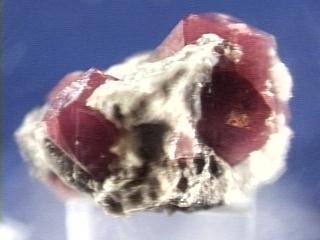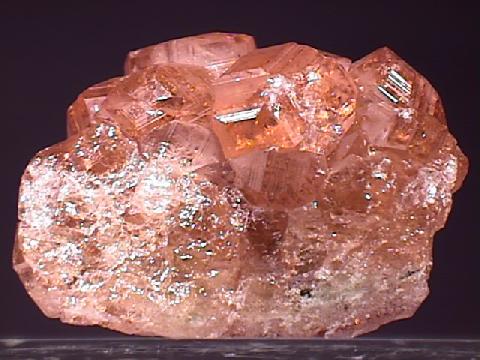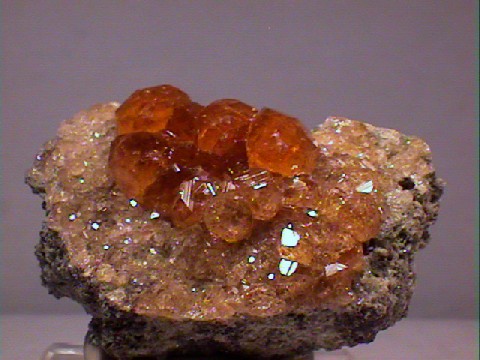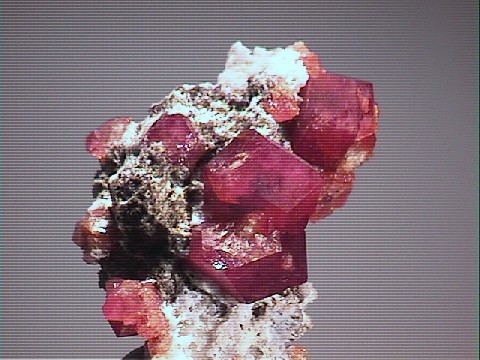 THE MINERAL GROSSULAR
THE MINERAL GROSSULAR
- Chemistry: Ca3Al2(SiO4)3, Calcium Aluminum Silicate
- Class: Silicates
- Subclass: Nesosilicates
- Group: Garnets
- Uses: abrasive, mineral specimens and as a Gemstone
- See our natural
Grossular Garnet Mineral Specimens
Also see variety specimens:Tsavorite Specimens
For Garnet Jewelry, see:GARNET JEWELRY
Grossular (also known as grossularite), like other garnets, forms rounded crystals with 12 rhombic or 24 trapezoidal faces or combinations of these and some other forms. This crystal habit is classic for the garnet minerals.
Grossular is the calcium aluminum garnet and forms in contact or regional metamorphic environments as does andradite the calcium iron garnet. It is believed that these garnets form from the metamorphism of impure siliceous limestones.
Grossular has many color possibilities and is probably the most colorful of the garnets. The orange variety is the most common and specimens of orange grossular crusts are prized by many collectors. The green variety is called tsavorite and is occasionally cut as a gem. Hessonite is a red variety of grossular and is also sometimes used as a gem.
PHYSICAL CHARACTERISTICS:
- Color is colorless, yellow, orange, green, red, grey and black.
- Luster is vitreous.
- Transparency crystals are transparent to translucent.
- Crystal System is isometric; 4/m bar 3 2/m
- Crystal Habits include the typical rhombic dodecahedron. also seen is the 24 sided trapezohedron. Combinations of these forms are common and sometimes the rare faces of the hexoctahedron, a 48 sided crystal habit that rarely is seen by itself, can also combine with these other forms making very attractive, complex and multifaceted crystals. Massive and granular occurrences are also seen. Commonly forms crusts that show many rhombic faces
- Cleavage is absent.
- Fracture is conchoidal.
- Hardness is 6.5 - 7
- Specific Gravity is approximately 3.5+ (above average for translucent minerals).
- Streak is white.
- Associated Minerals are micas, chlorite, diopside, calcite,
idocrase and serpentine. - Other Characteristics: index of refraction is 1.75 and many faces show a sort of striation caused by multiple crystal forms.
- Notable Occurrences are Asbestos, Canada; Mexico; Kenya; Italy and Sri Lanka.
- Best Field Indicators are crystal habit, color, environment and hardness.
 Amethyst Galleries' Mineral Gallery MINERALS |

$ 75.00

gro-2 ($ 75.00)

$ 55.00

gro-3 ($ 55.00)

$ 30.00

gro-5 ($ 30.00)

$ 120.00


gro-6 ($120.00)

$ 30.00

gro-7 ($ 30.00)

$ 80.00

gro-8 ($ 80.00)

$ 60.00

gro-9 ($ 60.00)

$ 150.00

gro-10 ($150.00)

$ 30.00


gro-11 ($ 30.00)

$ 30.00

gro-12 ($ 30.00)

$ 30.00

gro-13 ($ 30.00)

$ 120.00


gro-14 ($120.00)

$ 27.00

gro-15 ($ 27.00)

$ 57.00


gro-16 ($ 57.00)

$ 55.00

gro-17 ($ 55.00)

$ 95.00


gro-18 ($ 95.00)

$ 85.00


gro-19 ($ 85.00)

$ 48.00

gro-20 ($ 48.00)

$ 78.00


gro-21 ($ 78.00)

$ 30.00

gro-22 ($ 30.00)

$ 48.00

gro-23 ($ 48.00)

$ 54.00


gro-24 ($ 54.00)

$ 225.00


gro-25 ($225.00)

$ 40.00

gro-26 ($ 40.00)

$ 30.00


gro-27 ($ 30.00)

$ 30.00


gro-28 ($ 30.00)

$ 35.00


gro-29 ($ 35.00)

$ 75.00


gro-30 ($ 75.00)